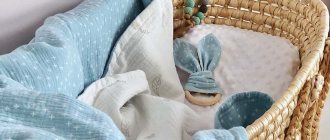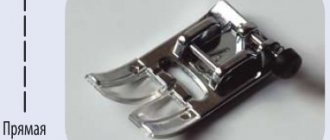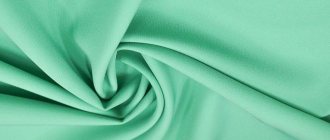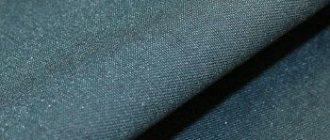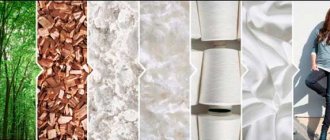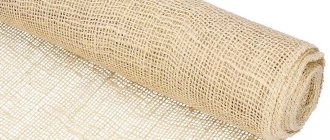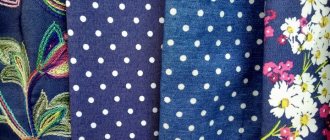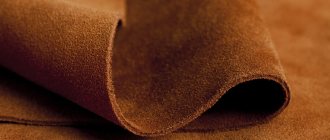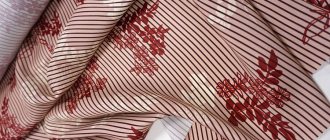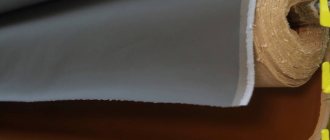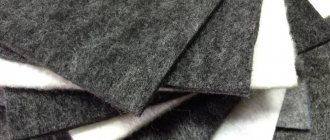Calico (from the Persian metkal) is a cotton material with a plain weave, characterized by special subtlety, resembling chintz in appearance. This fabric has a low density, as a rule, it serves as the basis for transformation into other materials - more comfortable, convenient and practical for use.
“Calico consists of fairly thick threads of unbleached yarn, usually has a grayish tint. This material is a semi-finished product for the production of various fabrics and other materials. If calico is properly processed, it can be used to produce chintz and various linen fabrics such as muslin and madapolam. Calico is also used to make leatherette and oilcloth. In the 19th century, calico was called paper fabric, as well as printed calico. Calico was used for upholstery and for the production of simple clothing. Calico was one of the exchange commodities on the Moscow Exchange.” Wikipedia
What type of fabric is this?
Calico is a natural fabric produced by plain weaving untreated cotton fibers. It has a simple weave of cream or gray shade, rough to the touch.
This textile does not have a very attractive appearance, so this fabric is transformed into more beautiful types. How are canvases produced? First, raw cotton is collected and then dried. Chemical treatment at cleaning stations dyes these fibers, creating a more attractive appearance.
As a result, cotton yarn is obtained, which is then woven on looms. At the final stage, the fabric undergoes impregnation, thermofication, as well as drying and ironing.
The advantage of calico
- environmental friendliness (calico is made from natural fibers, so the products are as safe as possible to wear);
- hypoallergenic (calico is used for sewing children's bedding, does not cause any allergic reactions and is pleasant to use);
- high levels of breathability (thanks to this property, the human body breathes and optimal conditions are created for comfortable wearing);
- hygroscopicity (this fabric is used for sewing clothes, and is also used in technical, medical, household and many other areas of production);
- low cost (this has a positive effect on the wide distribution and availability of the material);
- easy care (products made of calico do not require special care; clothes, as a rule, can be machine washed);
- a wide range of colors and styles (dyed calico is used for sewing shirts, shirts and other products);
- durability (due to the high strength of calico products, with timely care they will last for more than a single season);
Types of fabric
Types of calico:
Severe
Untreated fabric with a cream or grayish tint. May contain cotton debris. Application: making rags for cleaning, making a base for thick oilcloths.
Bleached
The processing of harsh calico consists of bleaching it, as a result of which a snow-white fabric appears. White material treated with a special caustic compound. Application: for sewing bed linen, shirts, and previously wedding dresses.
Painted
Canvas processed in different shades. A design printed on canvas creates chintz, while dyeing creates cretonne. Application: for sewing special uniforms, kitchen textiles, etc.
The history of calico
The appearance of calico is associated with India and Pakistan, where this material originated. Over time, calico became popular and began to be used not only in eastern countries. The material came to Europe from the east; the name of the fabric comes from the Persian word “metkal”, which literally translates as “coin” or “measure of value”. At that time it was a very popular material; it was traded and exchanged for food and other household items. Calico was highly valued and was sometimes used instead of money.
Great Britain became the first European country to begin producing calico. Over time, this matter gained popularity and widespread use. The production of calico in Russia appeared in the 18th century; cotton began to be grown as the main raw material for the manufacture of this material. It was one of the most sought after materials and the most sold product at that time. Russian varieties of calico began to appear: kumach fabric, the distinctive feature of which was its red color, as well as kindyak, which was painted blue.
Today, calico has not lost its position in the textile market; this material is still relevant and in great demand. Widespread distribution has a positive effect on its availability and price. Currently, this material acts as the main raw material for the manufacture of many other fabrics, from which clothes, accessories, bed linen, napkins, pajamas, tablecloths and other products are sewn. In addition, it is used as a mock-up fabric, which is later used for more precise cutting. This material is often used in construction; serpyanka is produced from it; due to its high strength and reliability, the material significantly facilitates the types of finishing work. At the same time, calico is used in the chemical and medical fields: it is used for filtering solutions.
Care
Like all natural fabrics, it is susceptible to microorganisms, especially mold fungi, so it must be stored and transported in special conditions, protected from high humidity. And it is also worth protecting the fabric from strong and frequent exposure to sunlight, since under the influence of ultraviolet radiation it turns yellow and deteriorates over time.
- Otherwise, calico is washed and ironed, like other cotton-based textiles.
- On the machine, use a temperature of 30 to 60 C°.
- For ironing, select the cotton mode.
- White items can be bleached, provided you are sure the fabric will not shrink from boiling.
- If necessary, hand wash can also be used.
- The product can also be taken to a dry cleaner for perchlor treatment.
The practicality of calico is evidenced by numerous positive customer reviews.
Characteristics and composition of the material
The fabric is quite hard to the touch with traceable weaves of threads, gray-beige in color - this is cotton calico fabric, a traditional natural material.
Calico is made exclusively from cotton without additives. Raw materials are selected of medium and low grade, sometimes even with garbage impurities (chintz, calico and other thin cotton fabrics are made from the best raw materials).
However, this does not mean that calico is of worse quality, on the contrary. Due to the fact that the raw materials did not go through all stages of chemical cleaning, they are more environmentally friendly.
The raw material is used to spin carded threads, from which calico is woven using the plain weave method (alternating weft and warp 1:1).
However, in modern production, calico is almost a semi-finished product. The canvas is further processed to obtain:
- muslin after mercerization and polishing;
- madapolam after finishing;
- calico after calcination or starching;
- leatherette, oilcloth after gluing with PVC platinum.
The resulting virtually new materials are not only painted, but printed, printed with patterns or decorated in other ways.
How to care for calico
Products made from calico are considered to be quite easy to care for; before putting your clothes in the wash, you should read the label on the product, which contains recommendations for caring for the items. We list the basic rules for caring for calico fabric, which will help maintain a presentable appearance and rich color throughout the entire life of the product.
How to wash calico
Cotton and synthetic-blend fabrics are generally machine washable. To do this, you should set the machine to “cotton” mode or use a delicate wash. The water temperature should be no more than 40 degrees. Thus, the structure of the material will not be damaged, the shape of the products will not change and the rich color will not be lost. You can wash it with regular powder or liquid gels. It is best to choose minimum or medium spin speeds, so the products will retain their shape.
How to dry calico
It is necessary to dry products made from calico in natural conditions, in a ventilated area. It is advisable not to leave items exposed to direct sunlight, as this can lead to discoloration and have a negative impact on the structure of the fabric. In addition, it is not recommended to dry things on a radiator, use a hair dryer or other artificial heat sources. The best option would be to dry things in a clothes dryer.
How to iron calico
Calico is a cotton fabric; items made from this material must be ironed using the iron’s delicate setting or the “cotton” setting. Clothes should be turned inside out; a good solution would be to use thin cotton lining fabric or gauze.
How to store calico
It is advisable to store products made from calico in a dry place, avoiding humidity levels above 10%. For long-term storage, items should be washed and dried; a good solution would be to store them in a fabric cover; it prevents the items from becoming dusty and prevents the formation of unpleasant odors. It is also recommended to treat products with special antibacterial agents that protect against moths and the formation of harmful bacteria. You should not store calico products in a closet next to radiators or on the balcony. Prolonged exposure to direct sunlight can damage the fabric structure and change the rich color.
Calico is a material with a rich history, the fabric has good performance properties, is used for sewing clothes, used in construction, in the technical and economic spheres of production. The material has gained particular popularity when sewing clothes. Calico products are of high quality, very reliable and practical. A wide selection of colors expands your choice. Today, calico is used as a basis for the manufacture of other materials. The relatively low cost has a positive effect on the distribution and availability of calico; this fiber makes excellent sets of bed linen, shirts and shirts. This is the optimal combination of price and quality.
Stages of work when using serpyanka
When sealing seams with serpyanka, you need to perform a number of actions that will lead to the desired result:
- Cleaning the surface from dirt. It is enough to wipe the wall or drywall with a damp sponge. You can add any detergents;
- Prime the surface before applying the material. This is done with the goal of bonding the putty to the material as best as possible;
- Application of universal putty;
- Applying serpyanka to a wet layer;
- Laying a thin layer of finishing putty;
- Drying the surface. The surface dries for about a day. In the room in which the finishing work took place, it is necessary to close the windows and doors. This is done to ensure tightness.
By adhering to all these rules, you can achieve a good result.
Description and features of serpyanka tape
Self-adhesive serpyanka found its purpose in sealing cracks and improving the planes of walls and ceilings. Used in finishing work indoors. For example, before painting and pasting wallpaper, gluing the joints of ceilings and floors with walls, smoothing the integrity of a plasterboard structure.
Made from fiberglass or synthetic fibers. Externally it is a wound roll, the width of which is 50 millimeters. In fact, serpyanka is a mesh .
It ensures ease of operation and absence of blisters on the surface. But the tape is not glued to the drywall itself, but to the putty surface. This gives good adhesion to the material. It has a mesh structure and is coated evenly along the entire length with a special adhesive substance, which makes working with it easier.
This tape is convenient:
- Glue seams;
- Smooth out cracks;
- Reinforce wall and ceiling panels.
In fact, the tape guarantees the safety of the putty layer on the surface and ensures the reliability of its connection with the drywall, and also prevents the occurrence of cracks. The characteristic distinctive features of the serpyanka are:
- Increased reliability;
- Moisture resistance;
- High level of adhesion;
- Anti-corrosion properties.
Having these properties, the fabric is used for interior and exterior work. Helps in the renewal of wall panels. Serpyanka is used to finish the joints of fiberboard, slabs and other building materials. Ideal for use in rooms with temperature changes.
Technical characteristics include:
- Density 50 g/sq.m;
- Size range from 42 to 230 millimeters;
- Length from 20 to 150 meters.
Types of fabric and their use
Depending on the type of raw material, different types of fabric are obtained. The difference is mainly in tactile and decorative properties; the density varies slightly.
| View | Density, g/m2 | Purpose |
| calico severe (severity t-2) | 70 | ritual supplies, rags, household needs, packaging, patterns |
| same article | 90 | lining for oilcloth or polymers, overalls, lining |
| bleached calico | 90 | home, children's clothing, household textiles |
| plain-dyed (analogues: calico, chintz, calico) | up to 110 | shirts, shirts, vests, curtains |
The loosest types are used to make canvas for embroidery, cushioning serpyanka, and they are also used as disposable packaging material.
How to choose a serpyanka?
In order to reinforce the seams of drywall sheets, it is better to purchase serpyanka, which has its own adhesive layer. It unwinds easily from the roll.
Due to the fact that the serpyanka consists of a mesh with cells, the putty mixture penetrates well inside and the seam is completely filled. If you have concerns about the strength of the glued structure, then you can exclude them. The entire structure will actually be held in place by putty.
Do not buy PVA glue under any circumstances! It is absolutely not suitable for gluing sickle paper or lavsan. This type of adhesive is partially water and can therefore come into contact with metal frames. This will affect the color of the putty and stains will appear through it.
So, when buying serpyanka for use, you need to:
1. Pay attention to the manufacturer. As a rule, all tape presented on the construction market is manufactured by domestic companies. Here you need to focus on price. You should not buy a completely cheap product, this will definitely affect the quality;
2. When purchasing a serpyanka, you need to check its overall integrity. If you can immediately see how the mesh is delaminating, then such a tape is not worth purchasing. Or, for example, the adhesive layer is completely dry.
Adviсe:
Using the tape is very simple, but there are a number of requirements that must be met:
- It is better to store the tape in its packaging. This is due to the fact that the adhesive base tends to dry out over time, and also to prevent dust from getting on the surface of the serpyanka;
- Air must not get between the serpyanka and the putty. This may lead to cracks;
- When cutting the tape, you must ensure its integrity. If the threads start to come out from any part of it, then you should simply cut off this part. These threads can damage the layer of material that was applied to the wall.
Advantages and disadvantages of calico
The fabric, which has been in constant demand for centuries, certainly has many advantages. Let's name the main ones:
- hygroscopicity;
- good air permeability;
- natural composition, which means safety;
- pleasant sensations when in contact with the body;
- minimal likelihood of initiating an allergy;
- ease of care.
Calico is popular both as an independent cotton material and as a basis for producing other fabrics. Cotton fabrics had the most affordable prices. In recent years, cotton has become an expensive raw material. That is why some manufacturers, in order to maintain profits and low prices for plain fabrics, reduce the consumption of raw materials. Accordingly, the characteristics of materials change. Buyers should take into account that natural cotton fabrics cannot be very cheap at current prices for raw materials.
Areas of use
- In addition to the fact that calico is used to make other fabrics, it is often used as technical textiles. It absorbs moisture well and is resistant to aggressive substances. It is used in cleaning as cleaning wipes.
- Samples of clothing are made from cheap material, adjusted, the necessary changes are made, and then put into mass production.
- The fabric is the best basis for the production of artificial leather - leatherette and the production of oilcloths.
We are surrounded by such a diverse world of cotton every day. We owe this largely to inconspicuous and modest matter. Calico is the basis of many types of natural and attractive textiles that make life brighter and more comfortable.
© 2021 textiletrend.ru
